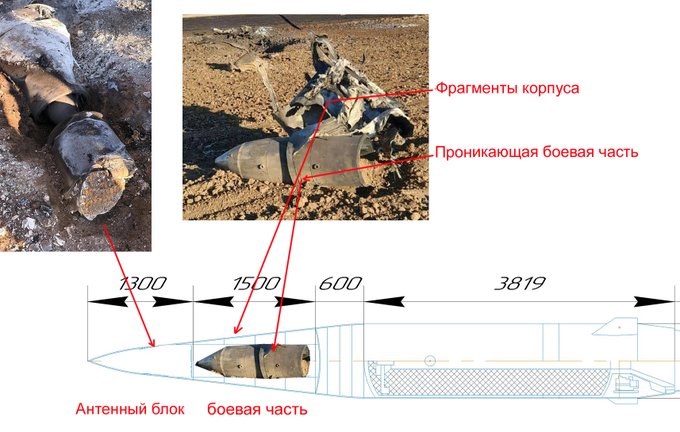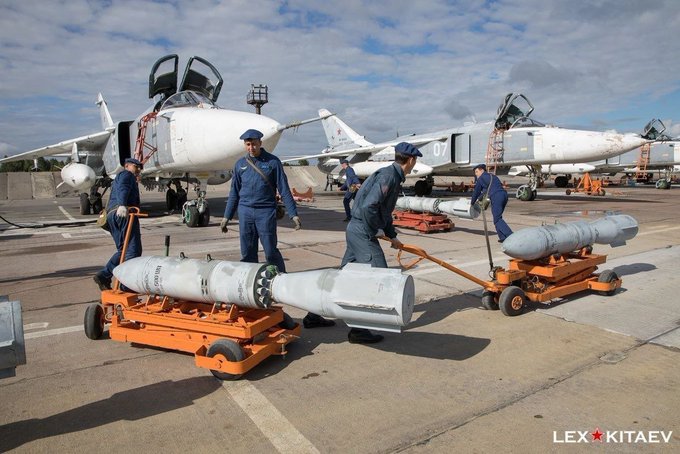Harsh competition ...
"Kinzhal" hypersonic aviation-missile complex

ALAMO- Posts : 7489
Points : 7579
Join date : 2014-11-25
Harsh competition ...
GarryB likes this post

Kiko- Posts : 3887
Points : 3963
Join date : 2020-11-11
Age : 75
Location : Brasilia
Moscow has already successfully used Kinzhal missiles in a combat situation amid the ongoing Russian special military operation in Ukraine.
Russia's Rostec state corporation head Sergey Chemezov announced on Sunday that his company had further increased the production of the Kinzhal (Dagger) hypersonic missiles.
He said: "Such a large quantity of this weapon was not [initially] required," but that the Kinzhals’ production has been increased since the beginning of the ongoing Russian special military operation in Ukraine.
So what is the Kinzhal missile and can it be referred to as a state-of-the-art weapon?
The Kh-47M2 Kinzhal (NATO reporting name "Killjoy") is a Russian nuclear-capable hypersonic ballistic missile, which has a range of more than 2,000 km (1,200 miles) and is typically launched from the Tu-22M3 bombers or the MiG-31K multi-role fighter interceptors at altitudes of about 18 km (11 miles).
The warplanes fitted with the Kinzhals have been deployed at airbases in Russia's Southern and Western Military District.
The Kinzhal missile is capable of travelling at least five times the speed of sound, or Mach 5, which is the definition of hypersonic.
The missile can reach a speed of up to Mach 10 (12,250 km/h or 7,612 mph) while also performing evasive maneuvers, which helps the Kinzhal to be virtually invulnerable to enemy air missile defence systems.
With the weapon’s advanced maneuvering capabilities, high precision and hypersonic speed, some sources refer to the Kinzhal as a "carrier killer" due to its purported ability to disable or possibly even sink a hypothetical 100,000-ton aircraft carrier with a single strike.
The missile aims to target NATO warships and missile defense systems, as well as the alliance’s land objects close to Russian borders.
The Kinzhal was reportedly designed to tackle any current or planned NATO air defenses, including the MIM-104 Patriot, Terminal High Altitude Area Defense and Aegis Combat System.
The overall design of the weapon is shared with the Russian-made short-range ballistic missile Iskander, which has a hypersonic speed of 2100–2600 m/s (Mach 6–7).
https://sputniknews.com/20230220/nato-carrier-killer-and-killjoy-what-is-russias-hypersonic-kinzhal-missile-1107618124.html
Big_Gazza, zardof, Hole and Broski like this post

RTN- Posts : 756
Points : 731
Join date : 2014-03-24
Location : Fairfield, CT
Zircon uses a rocket engine as well as a scramjet to reach its target because the scramjet is not developed enough.GarryB wrote:Zircon is a combined rocket and scramjet powered missile
That's why it needs assistance from a rocket engine.
Werewolf, Big_Gazza and lancelot dislike this post

thegopnik- Posts : 1825
Points : 1827
Join date : 2017-09-20
you dont know how scram or ramjet work do you?
sepheronx, GarryB, Werewolf, Big_Gazza, lancelot, TMA1 and Broski like this post

Big_Gazza- Posts : 4896
Points : 4886
Join date : 2014-08-25
Location : Melbourne, Australia
.Zircon uses a rocket engine as well as a scramjet to reach its target because the scramjet is not developed enough.
That's why it needs assistance from a rocket engine
The forum needs a facepalm emoji...
Werewolf, kvs, LMFS, Hole and TMA1 like this post

GarryB- Posts : 40537
Points : 41037
Join date : 2010-03-30
Location : New Zealand
Even early very low speed testing of Ramjets still needed another form of propulsion to get the platform moving before the scramjet or ramjet or pulsejet (like the V-1) could power the aircraft in flight.
Zircon, like Onyx before it, uses a rocket located inside its scramjet/ramjet engine to get airborne... claiming it is a weakness of the scramjet or ramjet is amusing.... are tomahawk cruise missile turbofan engines shit because they need a solid rocket booster to launch them from ships and subs?
The Onyx and Zircon are actually rather clever in the sense that the solid rocket motor is contained inside the ramjet motors and takes up no extra space like the tandem rocket motor that launches Tomahawks and western ramjet missiles like the Sea Dart, or American Standard SAM.
Big_Gazza, kvs, Hole, lancelot and Broski like this post

Backman- Posts : 2706
Points : 2720
Join date : 2020-11-11
GarryB, flamming_python, kvs, JohninMK, Hole and TMA1 like this post

GarryB- Posts : 40537
Points : 41037
Join date : 2010-03-30
Location : New Zealand
Very simply being launched at mach 2.5 and 18km altitude is a much bigger boost than being launched from maybe 10km altitude at subsonic speeds... the extra work the Chinese model would have to do to get to mach 2.5 and 18km altitude means less top speed and shorter max range... a higher altitude and faster cruise speed means more range... if you coast at mach 9 instead of mach 7 then in the minutes you are flying you cover more territory and travel further.
Not that that is an issue because the US Navy is going to struggle with either threat...
zardof and Hole like this post

Big_Gazza- Posts : 4896
Points : 4886
Join date : 2014-08-25
Location : Melbourne, Australia
GarryB, zardof, LMFS, Hole and Broski like this post

Arrow- Posts : 3472
Points : 3462
Join date : 2012-02-12
More of a physics question. Is Kinzhal able to increase its range to 2000km thanks to the speed and altitude of the Mig-31K?

flamming_python- Posts : 9541
Points : 9599
Join date : 2012-01-30
Wasn't the Kinzhal's range only 1500km, 1600km or something when paired with the Tu-22M3?

GarryB- Posts : 40537
Points : 41037
Join date : 2010-03-30
Location : New Zealand
The 2,000km range given for the Kinzhal is based on it being released from 18km altitude at a flight speed of mach 2.5, from a MiG-31K.
The flight radius of a MiG-31K at mach 2.5 is about 750km but I don't think that is included... upon launch the solid rocket motor in the missile will have a high energy fast burning core to launch the Iskander up into the air and carry it up to an altitude where it can roll over and cruise towards the target area so this high energy fuel accelerating a rocket that is already flying at mach 2.5 and is 18km above the ground and therefore already above the thickest area of the atmosphere means it can climb much higher and accelerate to a much higher speed than a ground launched missile from a stationary truck launch.
Think of it as a two stage missile... a first stage section and launched the missile off the ground and accelerated it to mach 2.5 and 18km altitude and now the main missile fires its main engine which allows it to climb higher and get to thinner colder air where there is less drag and it is able to fly rather faster without burning any extra fuel.
When launched from a Backfire we know it would have to be from rather lower altitude and probably at a subsonic or transsonic speed like say 10km altitude and mach 1-1.4 perhaps with four missiles being carried, but the flight radius of the Backfire will be rather more than the 750km of the MiG.
So it is a smaller shorter less powerful solid rocket booster that gets the missile into the air and moving but to a lower altitude and a lower flight speed, but still a very capable missile.
In both cases the Kinzhal is based on the Iskander so it has sensors and jammers on board and can release chaff and flares and jammers and also manoeuvre to make it really hard to intercept.
The control surfaces are fixed so the only way it can manoeuvre is engine thrust vectoring so the rocket motor burns all the way from launch to impact.
The is no information about Orc air defences ever intercepting Russian Iskanders.
Russian AD has shot down Orc Tochkas but it has grid fin tail control surfaces so it can manoeuvre but not as vigorously as the Iskander and Kinzhal can.
I would guess that from a MiG it can reach 2,000km, while the slower lower Tupolev it would be 1,200 to 1,500km range, but in both cases very difficult to intercept as a combination of high speed and manouver as well as self defence systems and equipment.
The range is determined by how long the rocket motor burns... when it burns out it would lose its ability to manoeuvre...
BTW a vertical dive on an aircraft carrier with the warhead set to explode underwater would be amazing to see... it would punch through the decks like a hot knife through warm butter and when it reached the water it would explode creating an enormous air bubble which would rise up and lift the ship out of the water, but obviously lifting a 100K ton ship out of the water in one place is going to break its back and sink it every time... moving at 3km/s will be astounding...
Big_Gazza, JohninMK and zardof like this post

Isos- Posts : 11601
Points : 11569
Join date : 2015-11-06
That's specially true for supersonic missiles that are more affected by air resistance.
And since the main goal is to sell the missiles, the numbers shared are always for the very top conditions.
For Kinzhal numbers shared are for a launch from a mig-31. For the tupolevs, they can just add a booster on the back since they are much bigger plateforms than mig-31 to get its range to 3000km easily.
owais.usmani likes this post

GarryB- Posts : 40537
Points : 41037
Join date : 2010-03-30
Location : New Zealand
For missile ranges you take into account the release speed and the altitude. R-77 is 70km in best conditions but roughly 50km in real battles. Kh-31 is 110km but falls to few tens of km when released at very low altitude. Export Oniks is 300km in the Hi-Hi-low trajectory but only 120 for the low-low-low one.
You are adding confusion here.
First of all during exercises between Malaysia and Australia, the Malaysians were "launching" at 80km range while the Aussie Hornets were launching their AMRAAMs at 50km.
The R-77 has a solid rocket fuelled engine.
The Kh-31 is accelerated by a solid rocket engine but is a ramjet powered missile.
The export version of Onyx is called Yakhont and it is also solid rocket booster (internal) with a ramjet sustainer for the rest of the flight.
The point is that both types of missile (jet and solid rocket) work rather better at higher altitudes which is just normal.
At sea level the air is warmer and thicker so the maximum speed any shape can be pushed through the air is much lower than the speed it moves at at much higher altitude.
An R-77 probably wouldn't get to more than mach 2 or mach 3 when launched from low altitude and if it remains at low altitude all the way to its target its range would likely be less than 40km.
AMRAAM would have the same problem.
Fired from a helicopter its range would be even worse because low flight speed will effect performance too.
Of course newer models of missiles massively increase range performance but still require high speed high altitude launch to get that improved performance, meaning being launched from slow aircraft like the F-35 that will likely never fly at mach 1.5 or faster puts any missile it launches at a serious disadvantage.
The best modern fighter is a small light aircraft that can accelerate and climb to speed and altitude very quickly and launch missiles at targets.
A 1,500km range Tomahawk missile does not fly at 20m altitude for 1,500km... likely the first 1,200km it will be cruising at a low throttle setting at 10km altitude or so at about 800km/h and then it will go to full throttle but drop to near sea level which means it will still be flying at about 800km/h.
Even for very short flights airliners tend to try to climb... the flights from where I am to a city 300km to the north, the first three quarters of the flight the aircraft climbs... the extra energy used to climb is recovered when you start to descend but the higher you get the faster you move for a given throttle setting so climbing almost always makes sense to shorten flight time and improve range in a jet powered aircraft.
For a missile, flying at low altitude an anti ship Kh-31 might only be flying at mach 1.8 if it is launched at low altitude and remains at low altitude all the way to a target 70km away. The same missile launched from 10km altitude at mach 2 and it will likely be moving at mach 3.5 for most of the way, which means targets 150km away will be in danger of the same missile... especially if it can dive vertically on the target and does not need to drop down low for the last leg of the attack.
There are very good reasons why most civilian airliners fly around the place at 10-14km altitude...
And since the main goal is to sell the missiles, the numbers shared are always for the very top conditions.
Anyone buying missiles know that the numbers are related but best case numbers.
An F-16 can carry 7 tons of external ordinance, but if you count up the weapon pylons and the types of weapons it can carry you will quickly work out that there is no loadout where it can actually have 7 tons of ordinance placed upon it... but most importantly even if it could it would never go into combat with 7 tons of ordinance... it would need full AB just to get and remain airborne and its ability to manouver would be pathetic.... it would be useless... but a good marketing number for sales.
Range and top speed and max payload cannot be achieved all at one time...
Of course some weapons can be more flexible... a scramjet powered missile can be throttled, while a rocket powered missile cannot... it burns at the rate it burns.
So if launched from low altitude a rocket powered missile will climb and accelerate, but at different altitudes its shape and thrust level is going to determine its top speed, so at very low altitude it might only be able to travel at mach 2 before drag overcomes the excess thrust the rocket motor is generating, so that extra thrust is just wasted because it does not make the missile go faster.
With a ramjet engine you have the advantage of sensing you are not going as fast as you should be so you can scale down the throttle to where you are going almost as fast as the solid rocket motor but using a fraction of the fuel... but because you are climbing then your potential top speed is increasing so you can gradually increase throttle to increase speed without wasting excess fuel... the problem with a ramjet is that you hit a top speed barrier that does not exist for a rocket motor because you have to manage airflows.
A scramjet motor can go as fast as a rocket motor in theory, but at one quarter the fuel weight because the oxygen needed for combustion can be scooped up along the way, but it can also be throttled so it isn't using full thrust at very low altitude where at best it might go mach 1.5 to mach 2... saving that fuel for when you have climbed 5km and can now go mach 4 with the same throttle setting, and then as you keep climbing you can ramp up the throttle to go faster and faster... once you get to very high speed you can throttle back to a setting that just overcomes drag which gets lower as you get higher so the higher you go the less fuel you need to burn to maintain speed and the faster you can go.
When you double your flight speed without increasing fuel burn you essentially cover double the distance in the same amount of time...
For Kinzhal numbers shared are for a launch from a mig-31. For the tupolevs, they can just add a booster on the back since they are much bigger plateforms than mig-31 to get its range to 3000km easily.
You certainly could, but I rather suspect they will be more interested in new designs of missiles for that job, because rockets are not efficient in comparison to jets except in terms of speed.
A rocket powered airliner would be all fuel and to make it practical the range would be shorter and the payload would be tiny... but the operating speeds would be excellent.
They use jet engines to give up enormous speed (which would create problems with heat and materials) to reduce the amount of fuel needed, to increase flight range and to be able to carry a decent amount of cargo or passengers or both.
A scramjet powered aircraft or missile gives you all the fuel efficiency advantages of a jet engine and reduced fuel weight because oxygen is scooped up on the way instead of carried in big tanks, but with the speed of rockets... obviously the problems with aerodynamics and space on board and heat issues with flying that fast need to be worked on.
Rather than putting a large solid rocket booster on the back of a Kinzhal, I would say actually putting a scramjet powered body on it would be more fuel efficient, but then replacing the entire missile with a scramjet powered missile make more sense.
From a ground launch from a stationary truck the Kinzhal can reach targets 500km away... putting it on an aircraft and accelerating it to mach 2.5 and lifting it 18km above the ground means it can travel four times further, but it is still a four ton missile, which is huge.
The Zircon travels at a similar flight speed and is probably 2-2.5 tons in weight and its performance is given at about 1,500km range, and it is a surface launched missile so the scramjet powered missile is half the weight of the solid rocket missile and has three times the flight range when launched from the ground.
This is because it does not carry its oxygen to burn as fuel so it can be much much lighter, but also because it can use its fuel efficiently depending on the conditions of launch like a fighter aircraft can.
A fully loaded fighter taking off uses full AB and that might seem inefficient but actually burning extra fuel to get airborne quickly and to climb and accelerate to higher speed is actually a very good use of the fuel... if you only used dry engine power you might save a few hundred litres of fuel, but it will take you much much longer to accelerate and to climb, which means you take much longer... so you end up flying a shorter distance and burning more fuel to get there.
Think of it in terms of driving a car... if you drive everywhere in first gear then you will reduce your speed and reduce your driving range... the faster you can get to a motorway and to motorway speed and then get into top gear and just idle along at top speed the further you can drive and the faster you can drive places.
Big_Gazza, JohninMK, zardof, Hole and TMA1 like this post

JohninMK- Posts : 15636
Points : 15777
Join date : 2015-06-16
Location : England
Bear in mind that a Kinzhal is 0.925m diameter and 7.93m length, presumably including tail cone.
In particular is the internal layout of the Kinzhal and presumably the Iskander classified? Also why would an internal warhead be this, possibly space inefficient, shape inside an aerodynamic shell?


https://twitter.com/AndreiBtvt/status/1656414635711508480?s=20
zardof likes this post

lyle6- Posts : 2586
Points : 2580
Join date : 2020-09-14
Location : Philippines
GarryB, kvs, zardof, Hole and TMA1 like this post

GarryB- Posts : 40537
Points : 41037
Join date : 2010-03-30
Location : New Zealand
claimed by Ukraine
Bullshit till proven otherwise I would say... they are not interested in the truth so why would I expect to hear it from their lips?
They are fighting a war and they never told the truth before... why would they start now?
Hole likes this post

ALAMO- Posts : 7489
Points : 7579
Join date : 2014-11-25
Logics, silly!
GarryB, kvs, LMFS, Hole, lancelot and Scorpius like this post

flamming_python- Posts : 9541
Points : 9599
Join date : 2012-01-30

JohninMK- Posts : 15636
Points : 15777
Join date : 2015-06-16
Location : England
GarryB wrote:claimed by Ukraine
Bullshit till proven otherwise I would say... they are not interested in the truth so why would I expect to hear it from their lips?
They are fighting a war and they never told the truth before... why would they start now?
I know that but it wasn't my questions.
Has anyone seen an internal layout diagram anywhere? Or is it classified? etc

GarryB- Posts : 40537
Points : 41037
Join date : 2010-03-30
Location : New Zealand
Dunno, he seems to have grown more honest in his old age
Hahaha... the senile old brain lets the truth slip by accident... how ironic...
Has anyone seen an internal layout diagram anywhere? Or is it classified? etc
The schematics for that missile are not yet on the internet as far as I am aware, but are they suggesting that this weapon failed somehow, because it looks rather intact which suggests if it is a warhead that it did not explode... coming in at not mach 3 but mach 10... 3km per second... I would think the impact would set off any HE contained inside it... a 3km/s collision would be more energetic than a small detonator exploding inside it at half that speed.

LMFS- Posts : 5161
Points : 5157
Join date : 2018-03-03
JohninMK wrote:Anyone got a comment on this? It's all about trying to find out what the weapon claimed by Ukraine around 12 May as a Kinzhal is. Part of one or say a BETAB-500 (photo below)?
These people (the Westerners believing this grotesque ukro propaganda) are living in an outright fantasy land where anything they wish comes true just because they want. They are so out of touch, it is not even funny anymore
kvs, Hole and Broski like this post

GarryB- Posts : 40537
Points : 41037
Join date : 2010-03-30
Location : New Zealand
If this was actually a genuine interception they would be screaming it on every western media network that Russian invincible technology is not invincible after all... yet they are not.
Big_Gazza and zardof like this post

Big_Gazza- Posts : 4896
Points : 4886
Join date : 2014-08-25
Location : Melbourne, Australia
kvs, Broski and Podlodka77 like this post

kvs- Posts : 15857
Points : 15992
Join date : 2014-09-11
Location : Turdope's Kanada
contributes to this as well. If the HE warhead fails to go off, it will still be obliterated. The kinetic energy is high enough. These Ukr
photo-ops are for retards, staged by retards. Their claims of having taken out several Kinzhals with a crappy Patriot system is part of
the same excrement.
Nobody seems to comment on the fact that Russia is using hypersonic missiles as if they are old news. No other military, including China,
has them. There has not been a single dud reported.
Big_Gazza, LMFS, Hole, lyle6, lancelot, Broski, Belisarius and Podlodka77 like this post


 ALAMO
ALAMO

